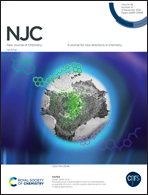Benzothiadiazole-based fluorophores as efficient non-doped emitters for solution-processed organic light-emitting diodes†
Abstract
Hybridized local and charge-transfer (HLCT) is an attractive strategy for achieving efficient electroluminescence (EL) in electro-fluorescent devices, owing to the transformation of the triplet excited state (T) to the singlet excited state (S) via a reverse intersystem crossing that gives rise to a high exciton utilization efficiency exceeding the spin statistical limit. However, most efficient HLCT-based OLED devices are fabricated by high-cost vacuum deposition of the HLCT emitters. Herein, two new solution-processable HLCT fluorophores (CBFPhC and CBFTPA) based on benzothiadiazole (Bz) derivatives are designed and synthesized. The photoluminescence emissions of these two HLCT luminogens are experimentally and theoretically investigated using the solvatochromic effect and density functional theory calculations. Both molecules exhibit a high solubility, HLCT characteristics, and an intense yellow-green fluorescence with solid-state photoluminescence quantum yields of 77–79%. They are successfully employed as non-doped emissive layers in solution-processed double-layered OLEDs, which produce intense yellow-green emission colors with low turn-on voltages (3.0–3.2 V), high maximum luminescence (31 920 cd m−2), high maximum efficiencies (EQEmax = of 5.91%, PEmax = 13.29 lm W−1, and CEmax = 13.18 cd A−1), and decent efficiency low-off.



 Please wait while we load your content...
Please wait while we load your content...